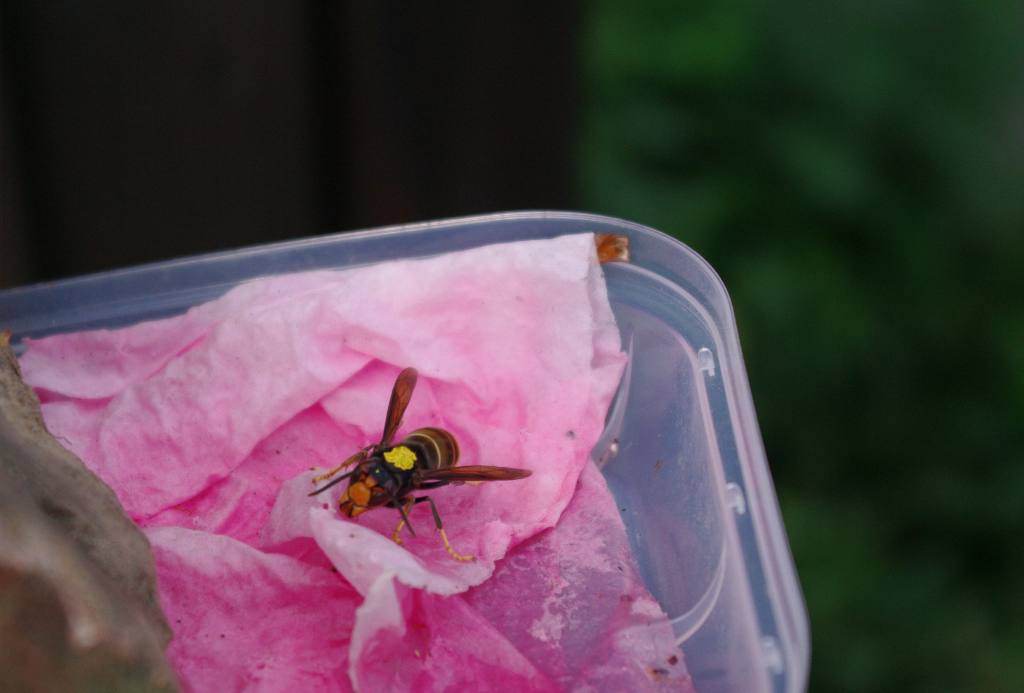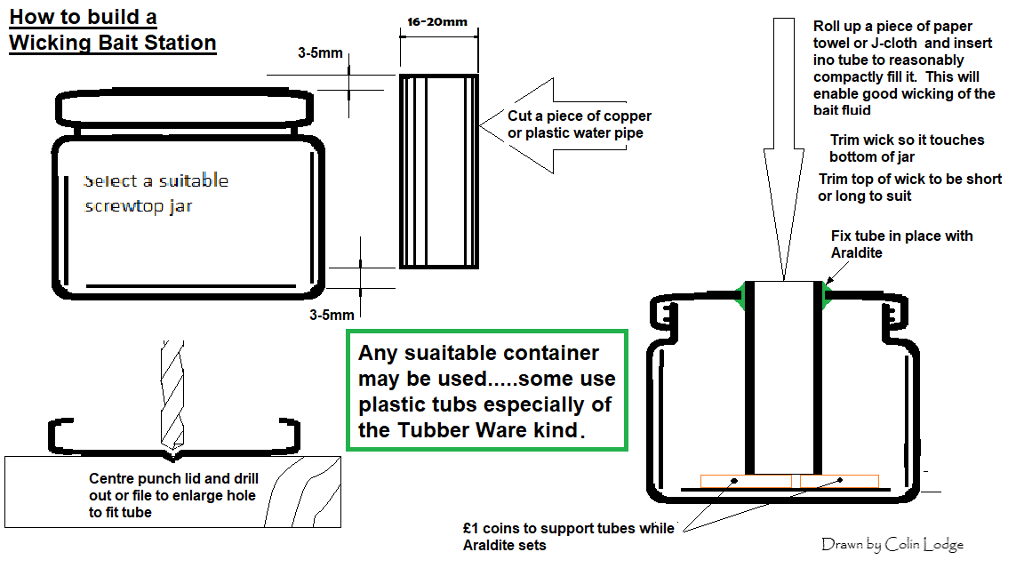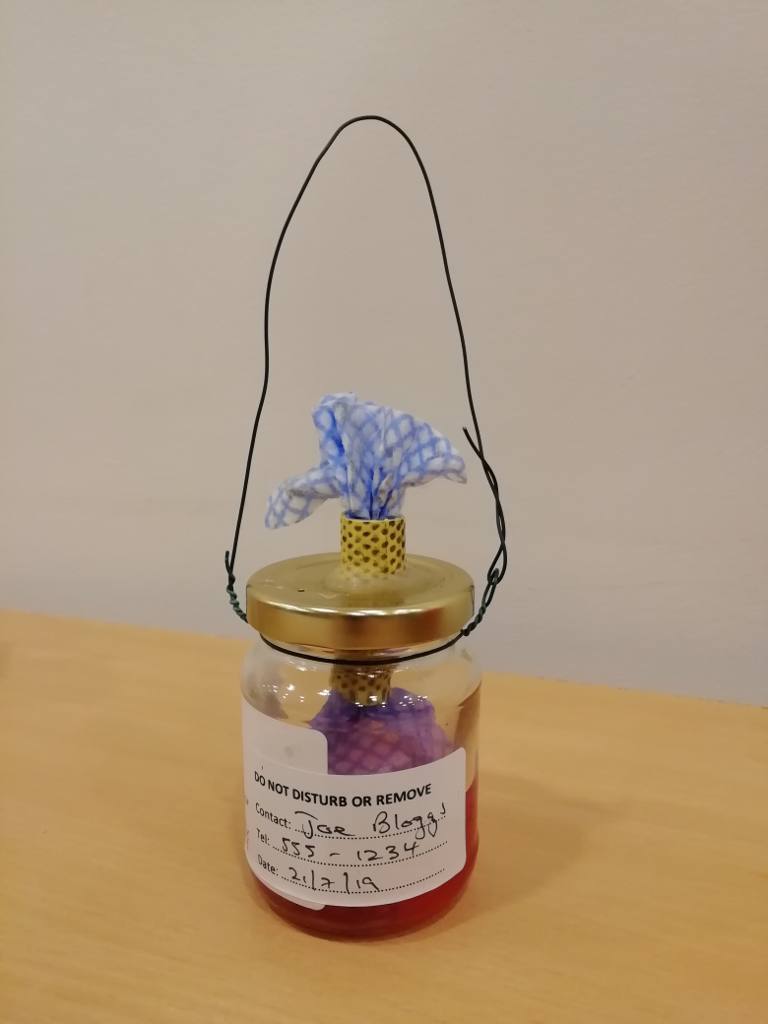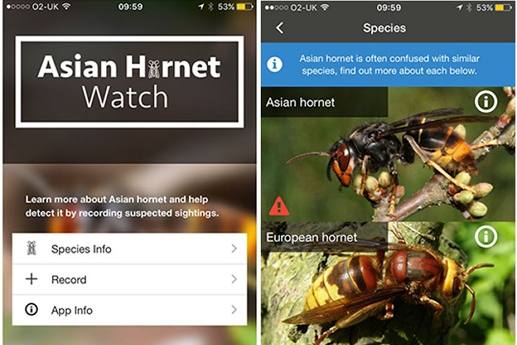Many of us are aware of the threat to our bees and to all our other pollinating insects from the Asian hornet (Vespa velutina). At this time of year, over-wintering queens may be coming out of hibernation and as part of a county-wide initiative to raise awareness of the problem, we are asking beekeepers and the general public throughout the country to help by setting up bait stations and to spread the word.
Please help to prevent this invasive non-native insect becoming established in the UK.
Setting up a bait station
In its simplest form, a bait station can easily be set up. All you need is a shallow dish, with a tissue or kitchen roll soaked in hornet attractant placed on an upturned bucket. The bait station should not be in your apiary, but somewhere sunny, and ideally in a position where it is easy to observe.

Open bait station in Jersey showing marked Asian hornet on attractant
© Simon O'Sullivan Creative Commons (CC BY-NC 2.0)
We are not asking you to watch the bait station constantly, but would like you to set aside some time in the day for observing.
For those who prefer to use a monitoring trap, please ensure they are regularly checked and any by-catch released to prevent them from drowning and being killed.
How to build a wicking bait station
If you have some basic marking skills, you may like to make the new wicking bait station, which is protected from the weather and uses less attractant.

© Colin Lodge, all rights reserved.
Instructions

- Select a suitable screw top jar
- Any suitable container may be used, some use plastic tubs, especially of the Tupperware® kind
- Cut a piece of copper or plastic water pipe (16-20 mm)
- Centre punch the lid and drill out or file to enlarge hole to fit the tube
- Role up a piece of paper towel or Jcloth and insert into the tube to reasonably compactly fill it. This will enable good wicking of the bait attractant
- Trim the wick so it touches the bottom of the jar
- Trim the top of the wick to be short or long to suit
- Fix the tube in place with glue, such as Araldite®
- Pound coins placed in the bottom of the jar will support the tube while the glue sets
- Add sufficient hornet attractant
- Place wicking bait station where you can regularly monitor.
Download instructions
For a more detailed tutorial of how to make your wicking bait station, download instructions.
Which bait station works best?
From experience in Jersey, the wicking bait stations have proven to be the best and offer greater benefits:
- Weather proof
- Larger reservoir of attractant
- Easily home-made
- Cloth wick with attractant keeps wafting scent into the air
- Easy to attract Asian hornets on the cloth wick
- Do not have by-catch (eg not killing other insects and pollinators).
Source: Permission kindly given by Government of Jersey to reproduce.
Where can I get hornet attractant?
Please contact your local AHAT Co-ordinator who will be able to supply you with hornet attractant.
If you are unable to get the hornet attractant due to the current Covid-19 restrictions on travelling, either of the following can used:
- Half litre of dark beer plus two tablespoons of sugar or honey.
- Half litre of water, three tablespoonds of sugar or honey, one cup of cider vnegar.
- Half litre of dark beer plus oone cup of black current cordial or Cassis.
What should I do if I see an Asian hornet?
Should you suspect you have seen an Asian hornet, try to take a sample (insect catch net), transfer to a jar and place in a freezer for one hour.
If you are not able to catch the suspected Asian hornet, take a photo of the insect on the bait station.
How do I report my sighting?
 If you think you have seen an Asian hornet (Vespa velutina nigrithorax), the quickest and best way to identify and report a possible sighting is to use the Asian Hornet Watch app which has been designed to record and help the early detection of Asian hornets.
If you think you have seen an Asian hornet (Vespa velutina nigrithorax), the quickest and best way to identify and report a possible sighting is to use the Asian Hornet Watch app which has been designed to record and help the early detection of Asian hornets.
The app provides an identification guide to help check which species you have seen and an opportunity to record your sightings. Download free of charge from Google Play or iTunes.
Alternatively, report the sighting to the Non-Native Species Directorate but they will need a good photo for identification purposes before taking any further action.
Please remember to also let your local branch AHAT co-ordinator know.
If you are unsure of correct identification, please use the Asian Hornet Watch App, or need help and advice, contact your branch Asian Hornet Action Team.
Spread the word
Please help spread the word to the general public about the Asian hornet to help them identify and report sightings.
Your local beekeeping branch should have leaflets available (while stocks last). Alernatively, you can download and print them to put up on notice boards in village halls, churches, schools, supermarkets, etc.
Find out more on how to get involved on our website.
Resources
For a full list of downloadable Asian hornet materials, including leaflets and posters, please visit the resources section of our website.
